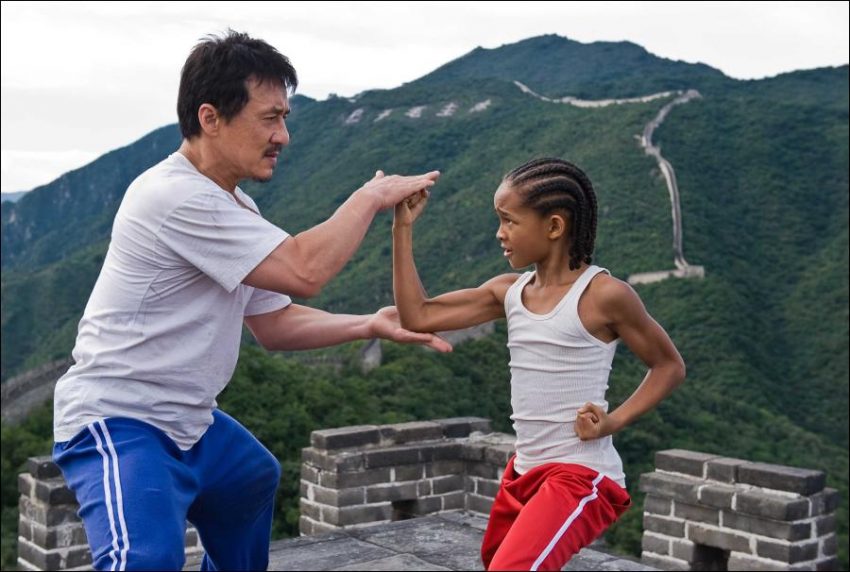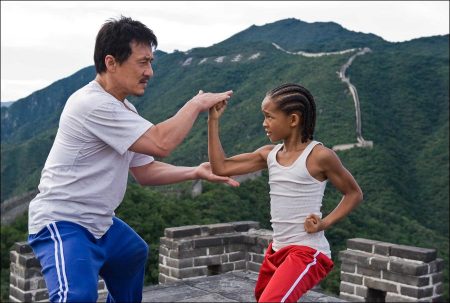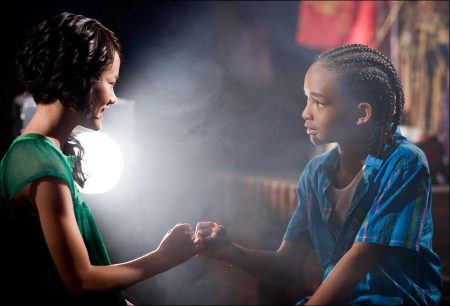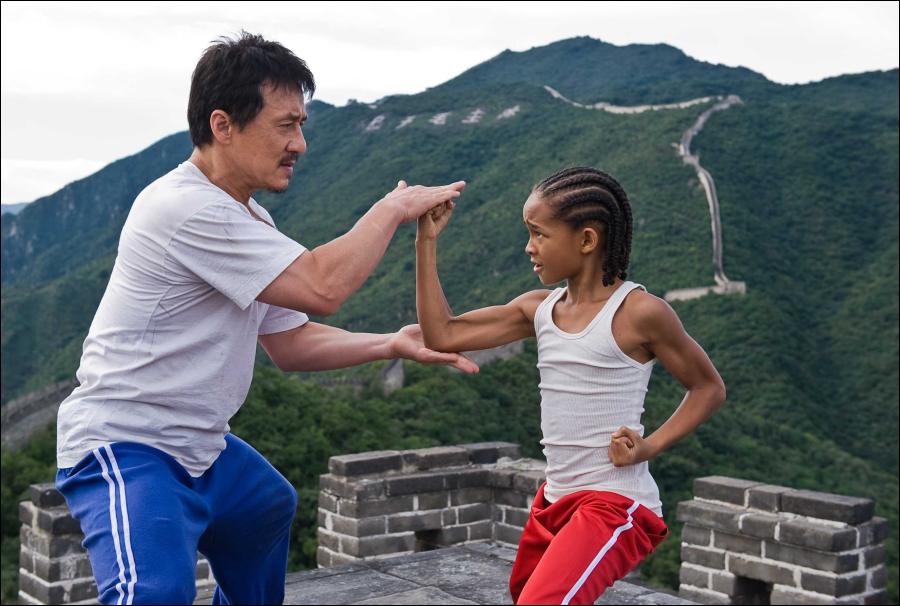Taglines: A challenge he never tmagined. A teacher he never expected.
In Columbia Pictures’ The Karate Kid, 12-year-old Dre Parker (Jaden Smith) could’ve been the most popular kid in Detroit, but his mother’s (Taraji P. Henson) latest career move has landed him in China. Dre immediately falls for his classmate Mei Ying – and the feeling is mutual – but cultural differences make such a friendship impossible. Even worse, Dre’s feelings make an enemy of the class bully, Cheng.
In the land of kung fu, Dre knows only a little karate, and Cheng puts “the karate kid” on the floor with ease. With no friends in a strange land, Dre has nowhere to turn but maintenance man Mr. Han (Jackie Chan), who is secretly a master of kung fu. As Han teaches Dre that kung fu is not about punches and parries, but maturity and calm, Dre realizes that facing down the bullies will be the fight of his life.
“Dre Parker is a cool American kid who’s left Detroit and now is just trying to make it in China,” says Jaden Smith, who previously starred alongside his father in the worldwide hit The Pursuit of Happyness and now takes the star reigns himself, headlining The Karate Kid.
“He’s definitely having a rough time – he feels like he just doesn’t fit in. He doesn’t mean to, but he gets on the bad side of some bullies. He’s got no friends and nowhere to go, and that’s when he finds out that his building’s maintenance man, Mr. Han, is a kung fu master. Mr. Han teaches him kung fu, and they end up having a special bond between them.”
It’s a theme that has long resonated with audiences – and explored in the hit movie of the same title that starred Ralph Macchio and Noriyuki “Pat” Morita. Morita’s portrayal of the stoic sensei, Mr. Miyagi, earned an Oscar nomination and passed into legend.
Producer Jerry Weintraub, who produced the first series of films as well as the new film, says that the story endures because its underlying story is universal. “Ultimately, it’s the tale of a father and son,” he says. “It’s not so much about the karate. What endures, what kids look to, is the story of a boy searching for a father and a mentor.”
It would be up to producers Will and Jada Pinkett Smith, James Lassiter, and Ken Stovitz, as well as director Harald Zwart to bring around this new version of the classic, updating it for a new generation.
“The teenagers who made the original Karate Kid a hit are now parents with kids of their own,” says Lassiter. “We wanted to remind them of the movie they loved so well – that we all love so well – but also make a modern movie that their kids can enjoy, too.” The new film couldn’t be a remake – it would have to capture those themes while standing on its own.
“The key for anybody in touching material like this is to make sure that you pay homage and respect to the original but somehow find a way to expand upon it and bring it to 2010,” says Zwart.
Perhaps the biggest challenge was in casting the role of the mentor. The filmmakers would need an icon—and they found one, in Jackie Chan. “Really, who else could do it?” says Stovitz. “Jackie is the only man who fits the bill. When I would say to myself, ‘We’re making Karate Kid with Jackie Chan in the Mr. Miyagi role,’ well, frankly, that was a movie I wanted to see.”
Chan felt a particular affinity for the story, as he admits he can actually relate to the young American character. “I understand the fish out of water story,” he says. “About 30 years ago, I went to America for the first time by myself. When you’re in a completely different culture, it’s very frightening.” With Chan excited to be on board, it seemed natural to the filmmakers to open up the story.
The karate kid would now pick up and move from Detroit to Beijing, China – truly upping the ante for a fish out of water. And since the setting is changed to China, it was clear that a number of things would be different – including the fighting style.
“We’re in a new country, and I learn kung fu,” says Jaden Smith. “The reason the movie is called The Karate Kid is that at the beginning of the movie, Dre thinks he can fight the bullies with a little karate he knows,” says Stovitz. “But in China even the kids know kung fu and they’re experts. So if Dre is going to survive, he has to learn kung fu.”
Of course, calling the movie The Karate Kid also seemed like a good way to honor the movie that came before. “The first movie has the famous wax on, wax off sequence,” says Zwart. “In our movie, Mr. Han tells Dre to put his jacket on and take it off a million times. If you’ve seen the first movie, you get the reference.”
Of course, the part required Smith to learn kung fu. He would learn from the best: Wu Gang, the stunt coordinator of the Jackie Chan Stunt Team. Because Chan performs most of his own stunt work in his films, Chan formed his Stunt Team in 1983 as a way to facilitate the fight choreography.
“When I first met Jaden, I liked him, but you can never be sure. I wasn’t sure if he’d really be up to the task,” says Wu. “He proved himself: he is very talented and he worked very hard. And it wasn’t easy. I loved training Jaden.”
Of course, in addition to the invaluable training from Master Wu, Smith had another way of learning kung fu. “I watched a lot of Jackie’s movies and even copied some of his moves,” laughs Smith.
In fact, an entire sequence – in which Mr. Han and Dre train and spar with sticks – is a reference of sorts to one of Chan’s earliest and most famous fights. Smith’s relationship with Chan really did mirror their characters’ in the film.
“He is amazing. He was always teaching me things,” says Smith. “How to stretch correctly, how to be in a scene, how to focus. He was right there with me the whole time.”
Harald Zwart says that the young star dazzled the filmmakers with his performance. “Jaden is charismatic and charming, but he’s also a fantastic actor,” says the director. “He fully committed to every aspect of the part. Not just the kung fu – which he worked very hard to learn – but the emotional story of the boy who becomes a man.” The director has equally high praise for Smith’s veteran co-star.
“Jackie is just fantastic to work with,” notes Zwart. “He never stops, and he loves the process of filmmaking, so he helps out with every practical aspect. For example, if an extra didn’t get a particular message due to the language barrier, he went over and respectfully whispered direction to them. He’s just wonderful and so helpful.”
The story tells the tale not only of a master and student but of the bond that’s formed between a lonely, childless man and a fatherless boy. Says Chan: “At first Mr. Han thinks he is only helping this bullied boy, but in the end, his life is also transformed.”
“Dre is like boys everywhere – they want to kick something, a way to get revenge,” says Chan. “But kung fu is not about hurting people. It’s about helping people.” Chan observes of his young co-star: “I’ve never seen a child that’s as clever as Jaden is. He learns whatever I teach him. I mean, I’d show him something and, boom, he got it right away. He’s amazing!”
Zwart recalls one poignant moment from the shoot: “I saw Jackie and Jaden relaxing between set-ups sitting on a little beach, you know, skipping stones in the water, and I was thinking if I was 11 years old and just hanging out with Jackie Chan, that would be a dream come true.”
Portraying Dre’s mother, Sherry, is Taraji P. Henson, who received an Academy Award nomination for her stunning performance in The Curious Case of Benjamin Button.
Henson says she was attracted to the role because it reminded her of the relationship between she and her own son. “We’re great friends, because it’s just the two of us, and that’s the thing that spoke to me when I read the script,” she says. “The new film also gave Sherry a larger ‘parental’ role. You really get to know Dre by watching his interaction with his mother,” Henson continues. “She’s a strong yet supportive woman.” Henson was impressed with how open the Smiths were in allowing her to form a credible relationship with their son.
“We had three weeks of rehearsals before we went to China. Both Will and Jada created such a comfortable environment for Jaden and I to bond,” she says.
“The Karate Kid” Learns Kung Fu
When the filmmakers decided to open up the movie and go to China, one change that became necessary was the fighting style that Dre would learn. He would learn a Chinese fighting style, rather than karate, which originates from Okinawa and Japan.
So the karate kid would learn kung fu. In one scene, the bullies mock Dre, calling him “the karate kid” for trying karate in the land of kung fu.
If Dre is going to survive, he will have to learn kung fu. The word kung fu has several different meanings, but it is not specifically a martial arts term.
The word might be literally translated as “work,” “skill,” or “time and effort” – a writer might have good kung fu at storytelling. At the same time, this term has a special meaning when applied to martial arts, and outside of China, kung fu can be used to describe the gamut of Chinese martial arts and a range of techniques.
In The Karate Kid, Dre learns wushu martial arts, a physically demanding, active kung fu sport taught and practiced in China. He was trained by Wu Gang, the stunt coordinator for the Jackie Chan stunt team, which is responsible for the stunts in the films that Chan directs.
Master Wu, as Jaden Smith came to call him, trained Smith for three months in Los Angeles before the production began in Beijing, then continued to train him throughout the four-month production.
“When I first met Jaden, he was just a kid,” says Wu. “A few months later, he was at the same level as kids that have been training for five or six years. He was very focused, very talented, and never complained. I’m very proud of him.”
They were starting at the beginning. “Whenever I teach anyone kung fu, but especially a kid, the first thing I teach them is respect for other people. Kung fu isn’t about fighting, but about helping people,” says Wu.
From there, Wu began training Smith in wushu. Despite the fact that they were making a movie, Wu says that the filmmakers were never tempted to rely on moviemaking tricks to make Smith look like he could do something he couldn’t. “No matter what, he had to learn how to move, how to fight, the basic training. There was a serious need for real kung fu, wushu learning.”
Of course, Smith and all of the other kung fu kids would be taught how to fight for the camera in a choreographed match and look good doing it on the big screen.
“All of the kids in the film are full time wushu students, but none of them had movie fighting experience,” Wu notes. “It’s not easy to get the timing, the rhythm, and the reaction when you get hit. Also, the drama and the acting in the fight are just as important as the action – the kids needed to tell the dramatic story of the fight with their faces and bodies. It’s very challenging. But the big difference with this movie is that the movements are real.”
Jaden Smith says movie fighting is not easy. “You have to actually hit the person – you do it softly, but you make it look hard,” he says. “You also have to block. If you don’t block the hit, you’re going to get hit in the face.” And did Smith enjoy his training? “He asked me to continue training him after the movie wrapped,” says Wu. “I was honored.” “Yeah, I want to stay buff,” says Smith. “If Taylor Lautner ever needs a stunt double, I’m ready for action.”
Filming in China
In adapting The Karate Kid for modern audiences, the filmmakers sought a location that would place as many obstacles in Dre’s path as possible. “We wondered, could we find a location that would be like dropping Dre in another world?” says Will Smith. “When we cast Jackie Chan as Dre’s mentor, it struck us – China. We knew we’d be asking for a challenge, but in the end, the setting not only made the theme stronger, but made the film epic. I couldn’t be more proud of what we accomplished in China. When you see Jaden and Jackie training together on the Great Wall, it strikes you – there’s no way we could have made this movie in L.A.”
The decision to take the entire production to China was not taken lightly. Because many of the desired settings in the story are off-limits and difficult to access, the producers turned to the China Film Group, the largest and most influential state-run film enterprise in the country, to assist in securing locations.
“One little shot took months of planning,” says Zwart. “Just as an example, we are the first film to be given permission to shoot inside the Tiananmen Gate and the Forbidden City since Bertolucci’s The Last Emperor more than 20 years ago.”
For Chan, this film was both a homecoming and a dream-come-true. “I am so thankful to the production company for filming in China. We may have a five thousand year old history but our government is only sixty years young, a new government. This movie will give audiences a chance to learn about Chinese culture as well as Chinese martial arts. Such a wonderful promotion,” he exclaims. Producer Jada Pinkett Smith observes that filming at actual historical locations only adds to an actor’s strength of performance.
“You can’t beat the energy that such a place can bring. You can’t recreate it. It’s a very special thing giving the movie authentic texture,” she says. “China is extremely unique, and this has been a really powerful experience for us as a family, working together in a place like this,” she continues. “It’s one of those once in a lifetime opportunities, one we’ll always remember. And of course, we’ll have a wonderful film to remember it by.” The production was headquartered out of the old Beiying Film Studios.
The “backlot” is essentially filled with hutong or passages between rows of siheyuan courtyard houses. Siheyuan is the traditional, albeit disappearing, style of residence of Beijingers, each consisting of a rectangular courtyard surrounded by one-storied tile-roofed houses, usually one to six meters wide.
The lot also featured an empty seven-story building which doubled as the exterior of Dre’s apartment building, “The Beverly Hills Apartments,” and as the rooftop where Mr. Han and Dre start training. Mr. Han’s house and garage were also built here using a mixture of existing old structures and set decoration.
A Beijing location – the Staff Residence Building #3 at the Beijing Forest University – doubled as the Detroit street where Dre and his mother start out.
One visually stunning scene in the film was shot at the prestigious Beijing Shaolin Wushu School and highlights 400 students dressed in traditional red gi doing their morning lawn routine.
Established in 1991, the school features education – primary through senior high – with a wushu-style philosophy.
Smith enjoyed working alongside his Chinese costars. “I learned a lot of kung fu from them, and I taught them their first English words: ‘Yo. What’s up.’”
The Karate Kid (2010)
Directed by: Harald Zwart
Starring: Jackie Chan, Jaden Smith, Taraji P. Henson, Wenwen Han, Zhenwei Wang, Jared Minns, Luke Carberry, Yi Zhao, Cameron Hillman, Luke Carberry, Ghye Samuel Brown, Shijia Lü, Bo Zhang
Screenplay by: Chris Murphy, Steven Conrad
Production Design by: François Séguin
Cinematography by: Roger Pratt
Film Editing by: Joel Negron
Costume Design by: Han Feng
Art Direction by: Second Chan
Music by: James Horner
MPAA Rating: PG for bullying, martial arts action violence and some mild language.
Distributed by: Columbia Pictures
Release Date: June 11, 2010








